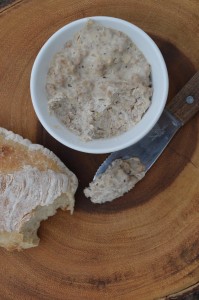Originally posted December 15, 2009 (if you can believe that). Re-posted today with some major corrections. I first read about cretons in an article in The Ottawa Citizen by then-food-columnist Ron Eade. He presented cretons as a Quebecois variation on rillette. A while back Emmanuel (Manu) of Pied Cochon, Joe Beef, and Woodwork fame gave me the skinny on cretons, and they really are not like rillettes at all. I am not able to find that original Ron Eade article to expose it. Presumably someone from the lower St. Lawrence forced him to remove it as libel or lies. Anyways.
 Cretons is a pork spread made by simmering ground pork and aromatics like onion, bay, and clove in milk or cream. As with any Quebecois dish there are as many variations as there are Francophones.
Cretons is a pork spread made by simmering ground pork and aromatics like onion, bay, and clove in milk or cream. As with any Quebecois dish there are as many variations as there are Francophones.
Pork. You can use regular ground pork. Actually the pork can be quite fatty as any lard that renders into the pan will be bound up with the dairy and (in my recipe…) breadcrumbs.
In addition to ground meat, Manu also adds gryons. This is the Quebecois word for greaves (see this post on rendering lard for more info).
Usually I’m a fanatic about searing meat, even the ground meat used in chili and meat sauce. Searing generally improves the colour and flavour of a dish, but there are a few notable exceptions. In my book those exceptions are veal blanquette and cretons. We want a soft texture and a light colour.
Onion. To me onion is essential as a sweet-‘n-savoury bridge between the pork and the spices.
Speaking of Spices. Clove seems to be the most commonly used spice in cretons. I use a standard quatre-épices blend of black pepper, cinnamon, clove, and nutmeg. These baking spices can easily become cloying, so use a light hand.
Dairy. Some use milk, some use cream. I use cream because it gives the final dish a rich texture but a happy, bright white colour.
Breadcrumbs. Again, not all recipes include breadcrumbs, but I like using them to bind up any pork fat that has gone adrift and floated to the surface of the mixture. Starch such as breadcrumb makes for a smoother, more cohesive spread.
Basically all these components are combined and simmered until the dairy has reduced and become a stodgy porridge. At this point the mixture is potted and chilled. It is most commonly eaten for breakfast, on toast.
Lazy Man’s Cretons. Oftentimes when I make pie I misjudge the ratio of dough to filling, and am left with a surfeit of one or the other. Excess pie dough is easy to get rid of (pie sticks!) Excess filling can be a bit trickier. If I have leftover tourtière filling, I put it in a heavy pot and cover it with heavy cream. If you simmer this mixture for about an hour it’s hard for an Anglo such as myself to differentiate it from true cretons. I have no idea what Quebecers would think of that, but it’s already happened so we should all move on.
Like many rustic preparations, cretons is a double-edged sword: on the one hand it’s almost impossible to not be tasty; on the other it is truly impossible to make it look appetizing in the modern sense. It is cold meat porridge, after all. But it’s delicious, and a great way to use up leftover ground meat.
Cretons
Ingredients
- 600 g ground pork
- 150 g onion
- 10 g garlic
- 1 tsp quatre-épices
- 470 g heavy cream
- 30 g bread crumbs
- 1.5 tbsp kosher salt
Procedure
- Gently cook the pork in a heavy pot. Do not colour the meat.
- Add the onions, garlic, and quatre-épices. Cook gently until the onions are starting to become translucent.
- Add the remaining ingredients. Simmer until the cream has reduced. The mixture should have the consistency of porridge. Roughly 45 to 60 minutes.
- Transfer immediately to ramekins or ceramic dishes. Chill thoroughly.
- Spread on toast.